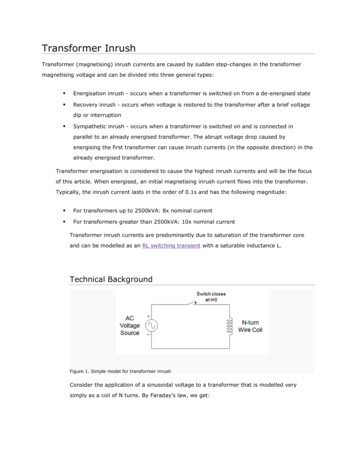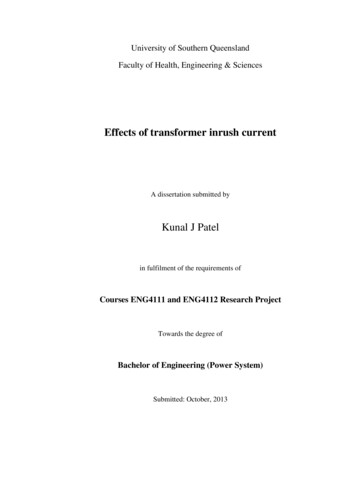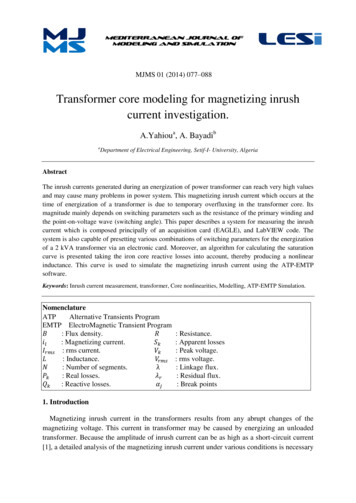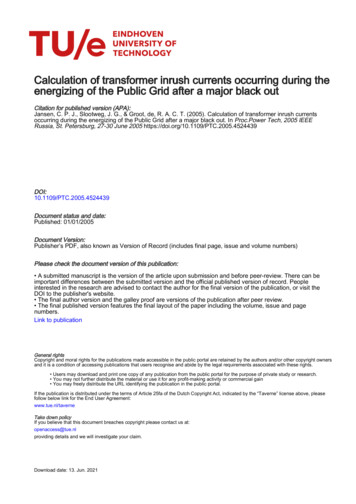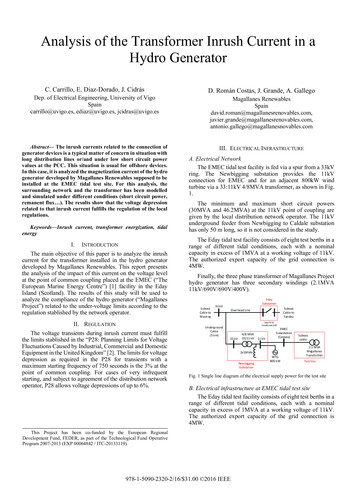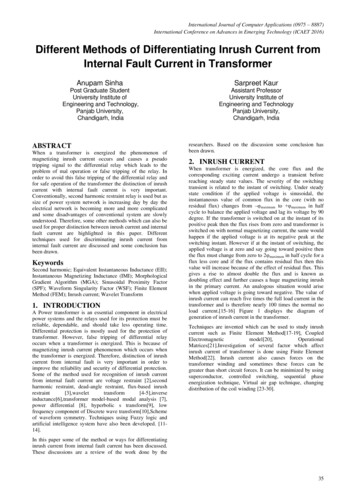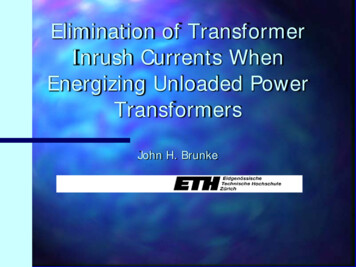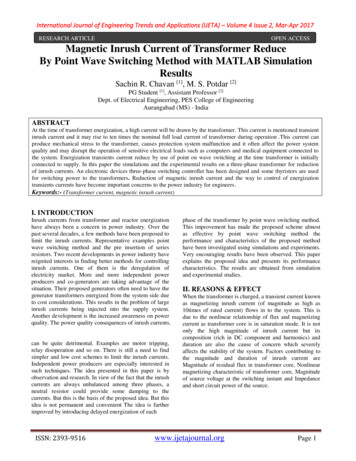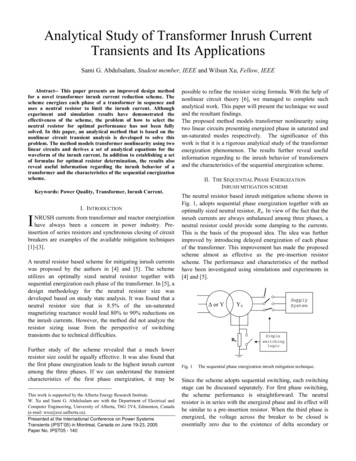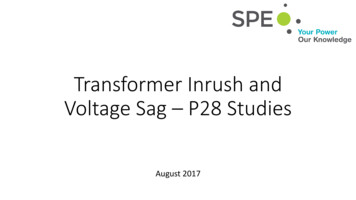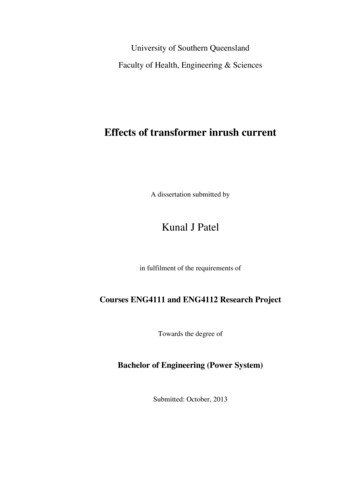
Transcription
University of Southern QueenslandFaculty of Health, Engineering & SciencesEffects of transformer inrush currentA dissertation submitted byKunal J Patelin fulfilment of the requirements ofCourses ENG4111 and ENG4112 Research ProjectTowards the degree ofBachelor of Engineering (Power System)Submitted: October, 2013
AbstractInrush current in transformer is often gets less importance compared to othereffects/faults. Though the magnitude of inrush current may be in some cases lessthan compared to short circuit current, the frequency and duration of inrush current isgenerally more frequent, hence it will likely have more adverse effect compared toother faults. Inrush current may flow when transformer is energised. The amount ofinrush current depends on when in the voltage cycle the transformer is energised andresidual flux in the transformer. The other type of inrush current is sympatheticinrush current which flows in already energised transformer when anothertransformer is energised in parallel connected line.This report contains basic principle, fundamental theory and relevant laws of thetransformer and inrush current. A number of factors affecting inrush current arediscussed. The inrush current theory and their equation are derived. The effects ofinrush current are described in brief. As a part of this project a number of effects andfactor affecting inrush current are considered for simulation. The Matlab Sim-Powersystem is used for the simulation. The simulation results compared with each otherand also data available from actual same size transformer. Finally six solutions toinrush current mitigation techniques with a practical low cost answer are provided.Page I
University of Southern QueenslandFaculty of Health, Engineering & SciencesENG4111 & ENG4112 Research ProjectLimitation of UseThe Council of the University of Southern Queensland, its Faculty of Health,Engineering & Sciences, and the staff of the University of Southern Queensland, donot accept any responsibility of the truth, accuracy or completeness of materialcontained within or associated with this dissertation.Persons using all or any part of this material do so at their own risk, and not at therisk of the Council of the University of Southern Queensland, its Faculty of Health,Engineering & Sciences of the staff of the University of Southern Queensland.This dissertation reports an educational exercise and has no purpose or validitybeyond this exercise. The sole purpose of the course pair entitled “Research Project”is to contribute to the overall education within the student’s chosen degree program.This document, the associated hardware, software, drawings, and other material setout in the associated appendices should not be used for any other purpose: it they areso used, it is entirely at the risk of the user.Executive DeanFaculty of Health, Engineering & SciencesPage II
CertificationI certify that the ideas, design and experimental work, results, analysis andconclusions set out in this dissertation are entirely my own effort, except whereotherwise indicated and acknowledged.I further certify that the work is original and has not been previously submitted forassessment in any other course or institution, except where specifically stated.Kunal J PatelStudent Number: 0061040223SignatureDatePage III
AcknowledgementsDR NOLAN CALIAOFor supervising the project and much appreciated continuous guidance.DR TONY AHFOCKFor granting access to this project and support.DR CHRIS SNOOKFor his much appreciated assistance and guidance throughout.MY FAMILYFor being patient and their support during this project.ERGON ENERGYFor sponsoring this project.Page IV
AbbreviationsAC: Alternating CurrentAVR: Automatic Voltage RegulatorCB: Circuit BreakerCT: Current TransformerCB: Circuit breakerDC: Direct CurrentGCB: Generator Circuit BreakerIEEE: The Institute of Electrical and Electronic EngineerskA:kiloampere 1000 ampsMVA: Mega volt-ampereA Area of coil in m2B magnetic flux density in tesla or wb-m2,Bm maximum value of flux density in the core in weber/meter2 normal rated flux density residual flux density saturation flux densityF mmf,H magnetic field strength in oersteds or A/m2,I current in amperesJ current density constant for 3 phase winding connection constant for short circuit power of networkL air core inductance magnetic path length in meter.N number of turnsP permeance.R total dc resistance Neutral earthing resisterR reluctance in At/Wb,t time core saturation pointVmax Maximum voltage open circuit positive sequence reactance of the transformer total impedance under inrush 0 r m permeability of air in H/m,permeability of material in H/m,fluxmaximum value of flux produced in the core in weberAngle between coil and lines of field in degreetime constant of transformer winding under inrush conditionsenergization anglePage V
Table of ContentsAbstractILimitations of sVTable of ContentsVIList of FiguresIXList of TablesXIIList of AppendicesXIII1. Introduction12. Background22.1.Flux22.2.Magnetic field intensity32.3.Magnetic flux density42.4.Reluctances42.5.Magneto motive force (MMF)52.6.Ampere’s law52.7.Faraday’s law62.8.Magnetic/electric circuit equitation72.9.Equivalent circuit82.10. Types of transformers132.11. Three-Phase Transformer152.11.1. Bank of three single phase transformers152.11.2. Three phase transformers152.12. Three phase transformer connections172.13. Eddie current172.14. Hysteresis effect193. Literature Review3.1. Inrush current theory21223.1.1. Energization inrush223.1.2. Recovery inrush223.1.3. Sympathetic inrush22Page VI
3.2. Factor affecting inrush current253.2.1. Starting/switching phase angle of Voltage253.2.2. Residual flux in core263.2.3. Magnitude of Voltage273.2.4. Saturation flux283.2.5. Core material293.2.6. Supply/Source impedance313.2.7. Loading on secondary winding323.2.8. Size of transformer323.3. Effect of inrush current333.3.1. High starting current333.3.2. Voltage distortion (harmonics)333.3.3. Sympatric inrush353.3.4. Vibration/geometric movement of winding363.3.5. Life of transformer363.3.6. Protection complexity - Actual fault v/s Inrush current393.4. Inrush current mitigation techniques423.4.1. Asynchronous switching v/s Inrush Current423.4.2. Neutral Earthing Resister v/s Inrush Current433.4.3. Comparison of various methods454. Methodology474.1. List of scenarios474.2. Modelling package494.3. Measurement techniques494.4. Existing arrangement494.5. Actual data sourcing514.6. Model & parameters515. Result & Discussion575.1. Model 1 – 3Ø transformer605.2. Model 2 – 3 x 1Ø transformers635.3. Model 3 – 3 x 1Ø transformers with NER at HV665.4. Model 4 – 3 x 1Ø transformers with sequential switch695.5. Model 5 – 3Ø transformer with sequential switch725.6. Model 6 – 3 x 1Ø transformers with NER at HV and sequential switch75Page VII
6. Conclusion787. References798. Appendices848.1. Project specification858.2. Project extended abstract878.3. Project timeline898.4. Project presentation96Page VIII
List of FiguresFigure 2.1 :Equitation of fluxFigure 2.2: Transformer at no-load conditionFigure 2.3: Phaser diagram of transformer at no loadFigure 2.4: Transformer on loadFigure 2.5: Phaser diagram of transformer on loadFigure 2.6: equivalent circuit diagram of a transformerFigure 2.7: Transformer phaser diagram for lagging and unity power factorFigure 2.8: Core and shell type transformers winding and core arrangementsFigure 2.9: Three single phase(left) and three phase transformer (right)Figure 2.10: Three phase transformerFigure 2.11: Eddy current and current induced by the external magnetic fieldFigure 2.12: Circulating current in thick, medium and thin laminationsFigure 2.13: Induced Eddie current density of solid to sliced (1,2 &4)Figure 2.14: Hysteresis loop/ B-H curveFigure 2.15: B-H curve for selected materialFigure 3.1: Inrush current for twice fluxFigure 3.2: Inrush current for twice residual fluxFigure 3.3: The optimum switching time for single phase transformersFigure 3.4: Inrush current (p.u) in first cycle v/s switching angle and residual fluxFigure 3.5.1: Saturation flux v/s inrush currentFigure 3.5.2: Effect of core saturation on secondary voltageFigure 3.6: Random orientation of microscopic fieldsPage IX
Figure 3.7: Field intensity v/s change in the domain orientations.Figure 3.8: B-H curves of various materialFigure 3.9: Field intesity v/s Permeability and Flux densityFigure 3.10: Example of core section lengthFigure 3.11: Spectrum of harmonics in inrush currentFigure 3.12: Harmonics contents of the idealised inrush currentFigure 3.13: Simulated RMS Voltage in kV v/s time in secondsFigure 3.14: Inrush currents v/s sympathetic inrush currentsFigure 3.15: The effect of system strength on sympathetic reactionFigure 3.16: Radial forces during inrush and short-circuit conditionsFigure 3.17: Axial forces during inrush and short-circuit conditionsFigure 3.18: Sample inrush currentFigure 3.19: Ratio of second harmonics to fundamentalFigure 3.20 : Flow chart to differentiate the inrush current and internal faultFigure 3.21: The difference in fault current and inrush current waveformFigure 3.22 : Idealised inrush currentFigure 4.1 : Three phase V, I and IFFT scopeFigure 4.2 : Simplified one diagram of actual system arrangementFigure 4.3 : Circuit breaker timing circuitFigure 4.4: Transformer output systemFigure 4.5: VI Meter subsystemFigure 4.6: Transformer hysteresis modelFigure 4.7: Transformer output systemPage X
Figure 5.1: Three phase transformer modelFigure 5.2: Three phase transformer model IabcFigure 5.3: Three phase transformer model FFT of IabcFigure 5.4: Three single phase transformers modelFigure 5.5: Three single phase transformers model IabcFigure 5.6: Three single phase transformers model FFT of IabcFigure 5.7: Three single phase transformers with NER modelFigure 5.8: Three single phase transformers with NER model IabcFigure 5.9: Three single phase transformers with NER model FFT of IabcFigure 5.10: Three single phase transformers with sequential switchFigure 5.11: Three single phase transformers with sequential switch IabcFigure 5.12: Three single phase transformers with sequential switch FFT of IabcFigure 5.13: Three phase transformer with sequential switchFigure 5.14: Three phase transformer with sequential switch IabcFigure 5.15: Three phase transformer with sequential switch FFT of IabcFigure 5.16: Three single phase transformers with NER at HV and sequential switchFigure 5.17: Three single phase transformers with NER at HV and sequential switchIabcFigure 5.18: Three single phase transformers with NER at HV and sequential switchFFT of IabcPage XI
List of TablesTable 2.1 Comparison between magnetic circuits and electrical circuitsTable 2.2: Differences between core and shell type transformersTable 2.3: Voltage and current ratings of common transformer winding configurationTable 3.1: Comparison of outcome of various methodsTable 4.0. Simulation parameterTable 4.1. Data Type Conversion Block PropertiesTable 4.2. From Block PropertiesTable 4.3. On/Off Delay Block PropertiesTable 4.4. PSB option menu block PropertiesTable 4.5. Relay Block PropertiesTable 4.6. Step Block PropertiesTable 4.7. Three-Phase Breaker Block PropertiesTable 4.8. Three-Phase Parallel RLC Load Block PropertiesTable 4.9. Three-Phase Source Block PropertiesTable 4.10. Three-Phase Transformer (Two Windings) Block PropertiesTable 4.11. Three-Phase VI Measurement Block PropertiesTable 4.12. Block Type CountPage XII
List of AppendicesAppendix A Project SpecificationAppendix B Extended AbstractAppendix C Project TimelinePage XIII
1. IntroductionTransformers transform electric energy. There are varieties of transformer and usedfor many different purposes. They are nearly inbuilt into every electric/electronicdevice around us. Power transformers are essential components in power systems.The large power transformers are considered to be important and very expensiveasset of electric power systems. The knowledge of their performance is fundamentalin determining system reliability and longevity. Potentially disruptive transientcondition may occur when an unloaded transformer is connected to the powersystem. Transient inrush current is often considered less important compared to othereffects/faults in the transformers. (Rahman et al 2012) The objective of this report isto understand the factor affecting the inrush current and effects of inrush current.There are five key parts of this report. The second and third part comprehends thebackground and relevant literature review. The background contains fundamentalprinciple, basic theory and relevant laws. The construction of transformer includingwinding configuration, hysteresis effect and circulating current are also described inthe background. Literature review is the third part, it mainly contains the theory ofinrush current, factor affecting inrush current and their effect. The methodologydescribes methods of how the key practicals will be performed. The list of keyselected simulation scenarios are described here. The technical specification of samesized actual transformer and their data is presented for comparison with simulationresults. Sim-power-system of Matlab Simulink was be used for the simulation.The result and discussion of model building and simulation are listed in section five.Here, the six selected scenarios are described with brief description of key differenceof the models and results. Finally in section six the conclusion with a practical lowcost solution to inrush current is recommended.The relevant information was sourced from varieties of resources. Majority of thereferences are from the relevant research, conference and journals of Institutes ofelectrical and electronics engineering. Significant parts of citation weree derivedfrom professional printed books. A number of figures and photos are sourced fromreputed internet sources such as manufactures, professional body, research institutesand universities. The appendix contains project time line chart and relevant projectsupporting information.Page 1
2. BackgroundTransformers are passive devices for transforming voltage and current. Atransformer is a static electrical device. The energy is transferred by means ofwinding’s inductive coupling via core. They are among the most efficient machines,95 % efficiency being common and 99% being achievable.Transformer are available and being manufactured in varieties of sizes andconfigurations. They are found in tiny microphone to large step up/step down powersystem distribution. They are found in most of electrical/electronic devices aroundus. Transformers are vital part of electric power system.The alternating current flowing through a winding produces alternating flux in thecore. This alternating flux links with other winding of same transformer andproduces electromotive force(emf) or voltage in these windingsIt is important to understand the basic principles and common laws in beginning. Inthis section in beginning common characteristic and their formulas are described.Equivalent circuit, transformer types and their winding configuration, Eddie currentand hysteresis effect etc. are briefed in short explanations.2.1 FluxFlux is defined as a rate of property per unit area. It is a vector quantity. Fluxes arelike lines in space. These flux lines or lines of force, show the direction and intensityof the field at all points. In magnets the field is strongest at the pole, it’s direction isfrom N to S (externally) and flux lines never cross. (Georgolakis 2009)The symbolfor magnetic flux is . The equation of flux can be expressed as, BA cos Where Flux in weber or Tesla-meter2,B Magnetic flux density in Tesla,A Area of coil in m2, and Angle between coil and lines of field in degree.Page 2
Figure 2.1 :Equitation of flux (Hsu NDT)2.2 Magnetic field intensityAn object in presence of external magnetic field produces force. As a result it linesup in the direction of field. The magnetic forced produced in the object is calledinduced magnetisation. The strength of magnetic field is called magnetisingfield(H)(Flanagan 1992). Magnetic field intensity is also known as magnetisingforce, is denoted by H and measured in A/m2. The equitation of magnetic fieldintensity is,H NI mmf Where H magnetic field strength in oersteds or A/m2,N number of tutns,I current in amperes, and magnetic path length in meter.2.3 Magnetic flux densityAs per name the magnetic flux density is an amount of magnetic flux per area rightangle to the flux (Devki Energy Consultancy 2006). It is denoted by B and unit isTesla or Wb m2. The equitation of magnetic flux density is,Page 3
B 0 rNI Where B magnetic flux density in tesla or wb-m2, 0 permeability of air in H/m, r permeability of material in H/m,N number of conductor,I current in ampere, and length of conductor in meter.2.4 ReluctancesReluctance in magnetic circuit is same as resistance in electric circuit. Reluctancevaries depending on material of core. Reluctance is opposition force that opposes theflux flow in the magnetic circuit. It is inversely proportional to the permeance(Gardner & Stevenson 2003). In equation form,R 0 r A 1PWhere R reluctance in At/Wb, length of conductor in meter, 0 permeability of air H/m, r permeability of material in H/m,A cross section area in m2, andP permeance.Page 4
2.5 Magneto motive force (MMF)Magneto motive force is magnetic potential. It is analogous to electromotive force orvoltage. It is a motive force that produces flux. Ampere-turn is a standard unit ofmagneto motive force. (Georgolakis 2009) The MMF creates a magnetic field in thecore having an intensity of H ampere-turns/meter alone the length of the magneticpath. Hence,mmf H NiWhere mmf Magneto motive force,H NI / , Length of conductor,N Number of coil turns, andi Current in the coil.2.6 Ampere’s lawThis is Ampere’s law which sate that the mmf proportional to the flux , isproportional to the inductor coil current and to its number of turns. Hence, accordingto Hopkinson’s law, Georgolakis 2009F R or F / PWhere F mmf,R reluctance, flux, andP permeance.Mathematically it can also be proven as below, BAPage 5
HA NIA ( B H )( H NI / ) NI / A mmf / A( mmf NI ) mmfR( R / A)2.7 Faraday’s lawWhenever there is change in the fluc linking with a coil, electro motive force isinduced in the coil. Change in flux linkage can be obtained by two ways, Coil isstationary and there is change in flux. (Gardner & Stevenson 2003)This will producethe statically induced emf.Flux is constant and the coil rotates. This will produce dynamically induced emf.The statically induced emf is convers electrical energy to electrical energy only. Thefirst applies to transformer where no moving parts are present however, thecontinuous change of flux produces the emf. The send applies to generator wherecoils are stationary and flux remains constant. Note that in AC generator, eventhough field winging are rotating the actual flux is constant as supply on of the fieldis DC. The rotation of constant flux which links with stationary stator windingcauses emf.The faraday’s law can be expressed by following equitation,e Nd dtWhere, e emfPage 6
N number of turnsd dt change in flux with respect to timeThe emf produced is proportional to the linkage of coil turns and also rate of changeof flux linkage. The statically induced emf is convers electrical energy to electricalenergy only.2.8 Magnetic/electric circuit equitationFlux density is line right angle flux in given unit area. The SI unit is weber/meter2 ortesla. The equation of maximum flux density is,Bm Where mAiBm maximum value of flux density in the core in weber/meter2 m maximum value of flux produced in the core in weberAi area of cross section of core in meter2The value of flux becomes zero to m when time isT1 4 4fIn terms of transformer the average value of emf induced in a turn of conductor is(Kulkarni & Khaparde 2004) change in fluxtime m 0 1 4f 4 m fPage 7
Now form factor RMS value 1.11Average value RMS emf 1.11 Average value RMS emf 1.11 4 m f RMS emf 4.44 m fFor N conductor, E 4.44 m fN E 4.44 Bm Ai fNMagneticMagnetic fluxMagneto-motiveforce (mmf)ReluctanceHopkinson’s lawPermeancePermeabilityMagnetic fieldFlux densityRelation betweenB&H( m Bm Ai )Symbol F H dlUnitWbA.tRF R1/HP 1/ RH HBB HH/mA/mH/mH/mElectricalElectric currentElectro-Motiveforce (emf)ResistanceOhm’s lawConductanceConductivityElectric FieldCurrent densityMicroscopic Ohm’slawSymbolI E dlR I RG 1/ R EJJ EUnitAV -1 /mV/mA/m2A/m2Table 2.1 Comparison between magnetic and electrical circuits (Physical process modelling NDT)2.9 Equivalent circuitTransformer has windings called primary and secondary. Primary winding is the onewhich get the electrical energy input and output is transformed in secondary. Thereare many different types of transformers however, here we will mainly discusspower transformers. Depending on core design the transformers are identified inmanly two categories known as core type or shell type transformers. In core typetransformers, winding encloses whole core where, in shell type transformers the coreencloses the windings.Page 8
Transformer works on the principle of electromagnetic induction. Figure 2.2 shows asingle phase transformer with two coils with no load on any of its winding. Thewinding are wound on core which becomes magnetic with alternating currentflowing in the winding. The primary winding is connected to source of whichalternating voltage V1 supplied. In beginning small excitation current flows i0 flowsthrough this winding. As this current is alternating mutual flux is induced in core(Gardner & Stevenson 2003). The primary and secondary winding contains N1 andN2 turns respectively. The instantaneous emf in primary winding caused by mutualflux is,e1 N1d dtWith assumption of zero resistance of winding,v1 e1Figure 2.2: Transformer at no-load condition (Kulkarni & Khaparde 2004)Since the voltage of primary winding v1 is, vm sin t , sinusoidal varying, the flux must also vary with at the rate of t . m sin tWhere mutual flux m pick value of mutual flux 2 fNow substituting value of in equitation of e1 we get,Page 9
d ( m sin t )dt N1 ( m cos t )e1 N1 N1 m cos t e1max N1 m e1rms N1 22 2 mfN1 m e1rms 4.44 f N1 mThis equitation is known as emf equitation of a transformer (Kulkarni & Khaparde 2004).The amount of flux and its density is determined by supplied voltage where numberof turn and frequency are considered as constant. Because m maximum value of fluxis flux density times the area which is constant hence, m Bm AiWhere m maximum value of flux produced in the core in weberBm maximum value of flux density in the core in weber/meter2Ai area of cross section of core in meter2Also the voltage induced in the secondary winding due to mutual flux linkage is,e2 N 2d dtSimilarly the induced voltage in secondary winding is, e2rms 4.44 f N2 mTherefor the ratio of induced voltages, e1 and e2, is,e1 N1 Turns Ratioe2 N 2Page 10
At this instance, no load condition as there is no load on secondary winding, thecurrent in primary wining is i0. There are two components of no load primary currenti0 ,1) i i0 cos 0This part is called active component. It consists of iron loss (hysteresis &eddy current loss) and primary winding copper loss.2) i i0 sin 0This part is called the reactive component or the magnetising component. Thealternating flux in the core is produced by this component.Here i0 i 2 i 2Figure 2.3: Phaser diagram of transformer at no load (Gardner& Stevenson 2003)When secondary winding of the transformer is connected to the load, secondarycurrent I2 flows. This current (I2) lags the secondary voltage V2 by 2 .The cos 2 isthe power factor of the load. (Gardner & Stevenson 2003) According to Len’z lawdue to this current I2, flux 2 is produced in the core, which opposes the flux produced by primary winding.So the net flux in the core tries to reduce. But the primary winding tries to maintainthe flux so the primary winding draws more current from the supply and keeps theflux as before. Thus due to the current I2 flowing in the secondary winding,balancing current I’2 flows through the primary winding. This current I’2 is 180o outof phase by current I2. Now, two currents flow through the primary winding-I2 andPage 11
I0. The vector sum of both the currents is called the primary current I1. This is shownin figure 2.4 and 2.5 as below.Figure 2.4: Transformer on loadFigure 2.5: Phaser diagram of transformer on loadIn actual transformer the primary winding has resistance, which is denoted by R 1.Similarly, the secondary winding resistance is denoted by R2. (Flanagan 1992)Actually, both these resistances are the distributed in nature but for simplicity, theseare shown as lumped resistance in following figure.The total flux produced by the primary winding does not link with the secondarywinding but some flux complete its path through air without passing through thecore. This is called the primary leakage flux L1 . Due to this leakage flux emf isinduced in the primary winding which opposes the primary voltage. To account forthis effect, it is assumed that the primary winding has reactance and the voltage dropoccurring in this reactance is equal to this emf. (Flanagan 1992) This leakagereactance is denoted by X L1 . Similarly, the total flux produced by the secondarywinding does not link with the primary winding and some flux completes the paththrough air. This is secondary leakage flux L 2 . Due to this leakage fluxelectromotive force is induced in the secondary winding. This emf opposes theinduced emf due to the main flux. (Gardner & Stevenson 2003) This effect isPage 12
indicated by the secondary leakage reactance X L 2 . The figure 2.6 shows theresistance and reactance of the primary and secondary windings and figure 2.7 vectordiagram.Figure 2.6: equivalent circuit diagram of a transformerFigure 2.7: Transformer phaser diagram for lagging and unity power factor2.10 Types of transformersThe transformers are classified mainly depending upon the geometry of the windingand core. There are two main types of this classification. (i) core-type transformerand (ii) shell-type transformer. (Devki Energy Consultancy 2006)(i) Core-type transformer. The core type transformer design is shown in figure 2.8.The primary and secondary wining are overlapped depending on the voltagePage 13
structure. Such design improves leakage flux (Farzadfar 1997). Generally the lowvoltage winding are first wound and high voltage winding are wound on the top ofLV winding. This ensures the HV winding away from core as core is earthed.Visually core are sounded by the coils. Such design has single magnetic/flux paths.Figure 2.8: Core and shell type transformers winding and core arrangements (Storr 2013)(ii) Shell-type transformer. The shell type transformer design are as sown in figure2.8. The winding configuration is same as core type. They contains five limb/legs.The visually coils are surrounded by the cores. In this design there are doublemagnetic/flux paths and hence it acts as low-reluctance (Li et al 2010).#Core type1The winding encircles the coreThe core encircles most part of the winging2The cylindrical type of coils are usedGenerally, multilayer disc type or sandwich coils are used3As windings are distributed, the natural coolingAs winding are surrounded by the core, the natural cooling does notis more effectiveexist.The coil can be easily removed for maintenanceFor removing any winding for the maintenance, large numbers of4Shell typelaminations are required to be removed.5The construction is preferred for low voltageThe construction is used for very high voltage transformerstransformers6It has a single magnetic circuitIt has a double magnetic circuit7In a single phase type, the core has two limbsIn a single phase type, the core has three limbsTable 2.2: Differences between core and shell type transformers (Your electrical home, 2011)The choice of type (whether core or shell) will not greatly affect the efficiency of thetransformer. The core type is generally more suitable for high voltage and smalloutput while the shell-type is generally more suitable for low voltage and highoutput.Page 14
2.11 Three-Phase TransformerA three phase power transformer are mostly used in transmission and distribution ofelectric power. The three phase transformer can be built by building a three phasetransformer or using bank or three single phase transformers. The primary andsecondary winding are connected according to circuit requirement however,generally in2.11.1 BANK OF THREE 1TRANSFORMERSThe three single phase transformer if connected in any of the three phase windingconfiguration works as three phase transformer. The widely used connections areThe figure 2.9 illustrates on left three single phasetransformer and on right a three phase transformer. The primary windings of both ofthis arrangements are in star and secondary are in delta. This makes then ideal foruse in their place.Figure 2.9: Three single phase(left) and three phase transformer (right)The primary and secondary windings shown parallel to each other belong to thesame single-phase transformer (on left). The ratio of secondary phase voltage toprimary phase voltage is the phase transformation ratio K. Phase transformationratio, K Primary phase voltage / Secondary phase voltage. As discussed earlier inemf equation the phase transformation ratio is K ( N2/N1).2.11.2 3TRANSFORMERA three phase transformer cont
Inrush current in transformer is often gets less importance compared to other effects/faults. Though the magnitude of inrush current may be in some cases less than compared to short circuit current, the frequency and duration of inrush current is generally more frequent, henc
